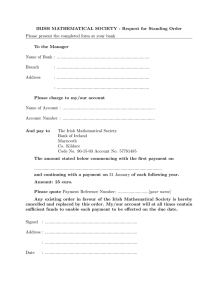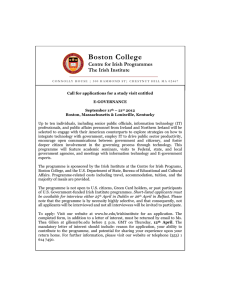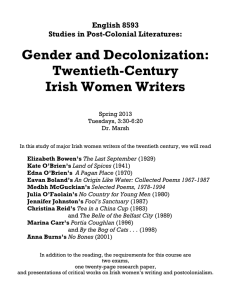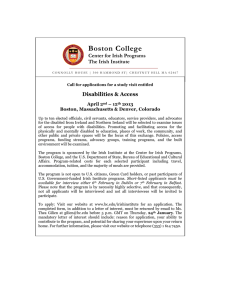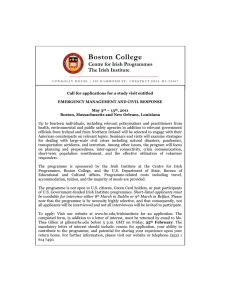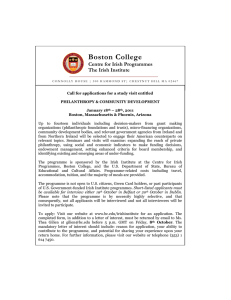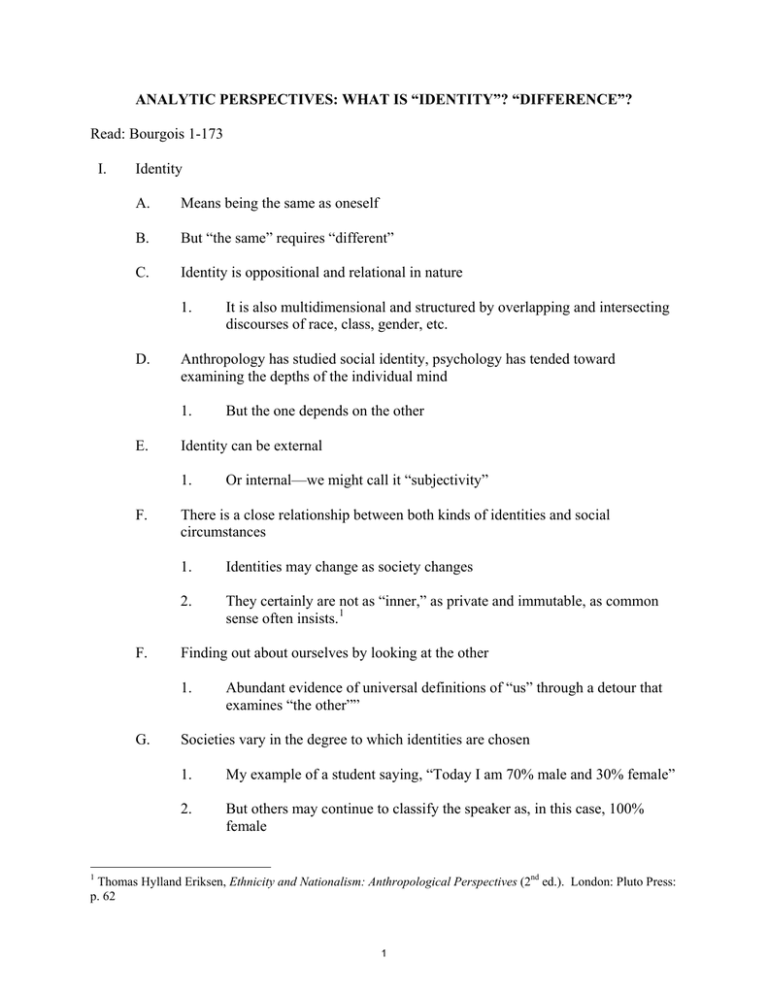
ANALYTIC PERSPECTIVES: WHAT IS “IDENTITY”? “DIFFERENCE”?
Read: Bourgois 1-173
I.
Identity
A.
Means being the same as oneself
B.
But “the same” requires “different”
C.
Identity is oppositional and relational in nature
1.
D.
Anthropology has studied social identity, psychology has tended toward
examining the depths of the individual mind
1.
E.
F.
Or internal—we might call it “subjectivity”
There is a close relationship between both kinds of identities and social
circumstances
1.
Identities may change as society changes
2.
They certainly are not as “inner,” as private and immutable, as common
sense often insists. 1
Finding out about ourselves by looking at the other
1.
G.
But the one depends on the other
Identity can be external
1.
F.
It is also multidimensional and structured by overlapping and intersecting
discourses of race, class, gender, etc.
Abundant evidence of universal definitions of “us” through a detour that
examines “the other””
Societies vary in the degree to which identities are chosen
1.
My example of a student saying, “Today I am 70% male and 30% female”
2.
But others may continue to classify the speaker as, in this case, 100%
female
1
Thomas Hylland Eriksen, Ethnicity and Nationalism: Anthropological Perspectives (2nd ed.). London: Pluto Press:
p. 62
1
3.
H.
II.
Because of appearance
b.
Or because, despite appearance, they “know” that “deep down
inside” she is female
Extremely important issue in this course
To understand identity, we need to find out about classification (ethnic, gender,
sexual orientation)
1.
We can call it categorical belongingness
2.
What lies behind the classifications? What makes sense to the people
involved?
3.
For example, there was no “homosexual” identity before 20th century
a.
Yes there was same-sex desire and sexual behavior
b.
Yes there were values regarding those feelings and acts
(opprobrium or tolerance)
c.
But “he likes men” is not an identity the way “homosexual” or
“gay” has become
Classification
A.
A kind of native theory whereby the infinite complexity of the experienced world
is reduced to a finite number of categories
B.
Systems of social classifications serve to order the social world and to create
standardized cognitive maps of categories of relevant others
C.
1.
Such systems of social classification and principles of inclusion and
exclusion always create order
2.
But the kind of order created is related to aspects of the wider social
system
Classifications are social and cultural products related to the requirements of the
classifiers
1.
D.
2
a.
Social classification always expresses power disparities 2
But with any classification we will always have “anomalies”
Eriksen, p. 60.
2
1.
Example: the DVD “One in 2000”
a.
About a kind of physical anomaly—anomalous according to a
certain system of classification
b.
The normative message of the DVD is that this shouldn’t be the
case
2.
Kondo was a physical anomaly according to the Japanese system of
classification
3.
DISCUSS: other examples?
a.
4.
Another example: 2nd and 3rd generation immigrants in Europe
a.
Turks in Germany
b.
They may feel they belong to both nations
c.
They may be bilingual
d.
They may have double citizenship
e.
They may experience conflicting loyalties
f.
They may say they do not feel at home in either
g.
These feelings may not be because the 2 cultures are incompatible
but because the ethnic ideologies hold that they are
5.
A student said, “I’m Mexican but I don’t feel Mexican”
6.
Gender: we may have notions about androgyny
a.
E.
“Funny, he doesn’t look Jewish.”
But we basically set up gender as either/or
Classification system may try to account for these anomalies
1.
Offspring of “mixed” couples
a.
2.
Ethnic, religion, race (Pascoe piece on miscegenation)
Some systems provide labels indicating mixture:
3
a.
II.
Metis in Canada, gens de couleur in Mauritius, mestizos in Latin
America
3.
But although these groups are classified, the label signals the anomaly
4.
Such “anomalous” people may exploit their ambiguity to their own
advantage
a.
Become cultural brokers, entrepreneurs
b.
In Colombia, a substantial number of indigenous leaders have an
indigenous mother but a non-indigenous father
History lessons
A.
Herodotus (Greece, 484-425 BC):
1.
The Libyan Tribes:
“The Lotophagi a tribe which lives exclusively on the fruit of the lotus;
among the Auses the women of the tribe are common property “and
intercourse is casual—like that of animals”…“it is amongst them that the
cattle are found which walk backwards as they graze”…“not to mention
dog-headed men, headless men with eyes in their breasts (I don’t vouch
for this, but merely repeat what the Libyans say), wild men and wild
women…” 3
B.
3
2.
Much of it from hearsay
3.
But he was trying to objectively give an account, for example, of the
Scythians, and he tells us that his account of the Persians comes from his
own observations
4.
This is why he’s referred to as the father of history, and sometimes the
father of anthropology
Ibn Fadlan: another well-known early ethnographer (who documented “the
other”):
1.
Scandinavians on the Volga in 922
2.
Observed carefully and comprehensively and carefully wrote it up
From Herodotus, The Histories, trans. Aubrey de Sélincourt, 1954. Penguin Books, pp. 299-308.
4
3.
Although the Scandinavians’ customs were very different, Ibn Fadlan
didn’t describe their bodies as different
a.
C.
Travelers, explorers, government administrators
1.
Left accounts describing people, societies, cultures
2.
Almost always there’s a hierarchy: we are superior, they are superior, or a
mix
3.
But in fact, with rare exceptions, “they” are inferior
4.
D.
E.
Unlike Herodotus’ Libyans
a.
Their sexual habits
b.
What they eat
c.
How they talk
d.
Herodotus writes of “Ethiopian hole-men, or troglodytes…and
speak a language like nothing upon earth—it might be bats
screeching”
Sometimes “the savage” is nobly savage
a.
The writings of Montaigne, Rousseau
b.
But they were mainly interested in critiquing the European society
of their time
There is universal interest in knowing about “others” whose difference is
significant to “us”
1.
Difference may be physical
2.
Oftentimes, as we saw in last week’s reading, difference in bodies,
customs, morals, etc., are merged in the accounts
3.
And we also saw that all too often the descriptions are wrong
a.
Due to ignorance
b.
Or due to projections, biases, preconceived notions
What can these “others” tell us?
5
1.
III.
a.
“Primitive” woman has a brain almost the size of “primitive” men
b.
And a much stronger body, etc., than civilized women
c.
Parisienne’s brain “the smallest on record” 4
d.
Durkheim’s conclusion: the evidence shows that woman sacrificed
a lot in the journey of evolution, in order to achieve civilization
As well as universal interest in comparing “us” to “others,” universal interest in
comparing “us” to “abnormals” and to “non-humans”
A.
B.
“Abnormals” are individuals rather than groups
1.
And live within the community (or are institutionalized)
2.
Cartoon character Police Detective Dick Tracy’s criminals almost always
show a correlation between deformed body and deformed mind
Non-humans
1.
2.
3.
4
I mentioned in class Emile Durkheim’s notion of the primitive female
being superior to her civilized counterpart (the most civilized being, of
course, the Parisienne)?
Have human-like bodies, but something’s wrong or at least missing
a.
Witches, ghosts, zombies, werewolves, Dr. Frankenstein’s
monster, vampires
b.
Fairies, elves, giants, trolls, dwarves
c.
Seen as different on the inside, too
Or have human-like bodies but are more powerful
a.
Wizards can do good
b.
Amazons
Or are human-like but seen to be eternally within the wilderness—elusive,
want to be left alone
Division of Labor in Society.
6
a.
C.
Gray area between non-human and subhuman: “the savage” “the wild man”
F.
DISCUSS: Examples of human-like bodies; create a typology
1.
The body is the same in some way, but profound change
a.
2.
3.
Dracula
The body comes into being via new technology
a.
4.
Dr. Jekyll and Mr. Hyde (Robert Louis Stevenson)
The body looks human, isn’t
a.
Frankenstein’s monster
The body changes because of external change
a.
VII.
Abominable Snowman of the Himalayas; Sasquatch in Northwest
Coast of U.S. and Canada, Yeti
Werewolves of London
Classification system closer to home:
A.
The Irish, who started immigrating as early as 1740, were stereotyped by English
Americans 5
1.
On the one hand Irish were encouraged to settle on frontier as a barrier
against Native Americans
a.
But the Irish were resisted in more settled areas, persecuted, some
gave up their Catholicism
b.
By 1790 10% of the white population was Irish
c.
Many more immigrated between 1870 to 1925: famine, poverty
1)
B.
Came from an agricultural setting, so had few urban skills,
but low wages and institutionalized discrimination
Familiar stereotypes early on: lack of intelligence, ingratitude, wickedness,
ignorance
5
Material on the Irish from Joe R. Feagin and Clairece Booher Feagin, Racial and Ethnic Relations, 6th edition, pp.
103-113.Upper Saddle River, NJ: Prentice Hall, 1999
7
1.
As immigration surged the stereotypes changed, emphasizing conflict and
hostility
a.
2.
Examples of put-downs: “Paddy wagon” (Patrick); “Irish buggy” for
wheelbarrow, “Irish promotion” for demotion
a.
C.
DISCUSS: ethnic jokes pick on which groups today?
And the Irish body was seen to differ:
1.
2.
The notion that the Irish were apelike—the “missing link” between gorilla
and human race
a.
Was imported from England
b.
Social Darwinism and threat of Irish rebellion
Irish were depicted with abnormal pug noses
a.
VIII.
They were said to be temperamental, dangerous, quarrelsome, idle,
reckless
Contrasted with stereotypes of Jews with enormous noses
Analyzing the classification systems and their content, we see that they do a lot of
cultural work
A.
First, they show us more systematically, more explicitly who “we” are
B.
Second, they teach us, teach our children about identity and difference
C.
Third, they show the importance of community, one’s membership in it
D.
Fourth, they illustrate proper behavior
E.
Fifth, they explain unwanted phenomena
1.
Something wrong with the body often indicates something more generally
wrong
2.
Explanations of illness frequently point to a breached taboo, etc.
8
MIT OpenCourseWare
http://ocw.mit.edu
21A.218J / WGS.170J Identity and Difference
Spring 2010
For information about citing these materials or our Terms of Use, visit: http://ocw.mit.edu/terms.

